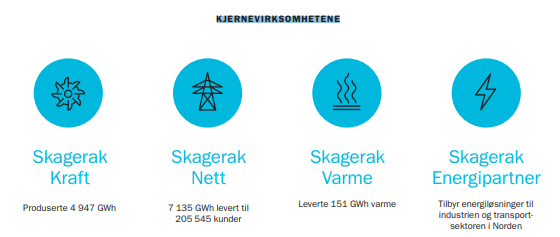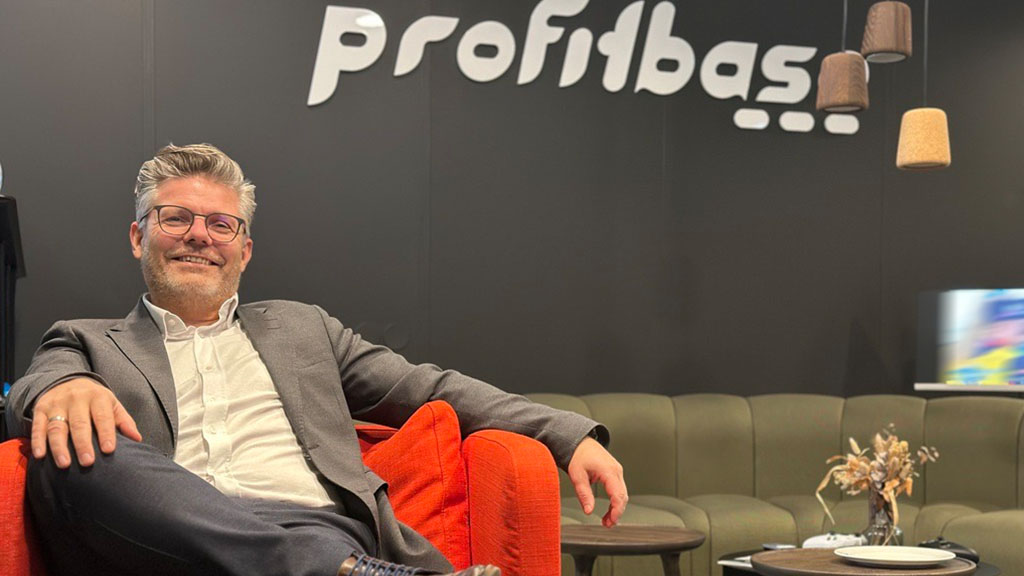
Norway’s energy sector requires flexible financial planning and insightful simulation for future growth.
Norway’s energy sector is a complex one, with its main activities centered on electricity production and trading, distribution, and retail. The sector can be sectioned into three main areas:
1. Electricity production companies
3. Group/enterprise planning companies
These three companies have different needs when it comes to the use of Enterprise Performance Management (EPM) to maximize their strategic goals. Some of these companies have expanded by providing other offerings such as broadband and energy solutions and in recent years also other forms of renewable energy.
Group companies such as Skagerak Energi cover all the main areas of the energy sector, as shown in figure 1 below.

Figure 1. Skagerak Energi supplies clean energy, and its core business consists of: power supply, grid production, heat supply, and partnerships to offer energy solutions in the Nordic region. Source: Skagerak Energi Annual Report 2019.
1. Power supply companies
Power supply companies have financial planning needs with more complex requirements for interfaces, functionalities, and calculations for areas such as:
- Power prices: price curves – simulation; sensitivity analysis; system price and area price
- NIBOR interest rate with mark-up for long term planning
- Water, wind, sun, and other environmental assumptions
- Land rent compensation
- Partially owned power plants
- New power plants with a start date, which goes from being a project/investment to starting production.
- Long-term horizon for planning, inflation adjustments
Power supply companies require long-term investment and planning needs, for example, on maintenance and production. Power companies need to plan ahead for their power production – think about what the interest rates will be like in the next 25 years. Moreover, they need good knowledge and insight of what to expect with the price curve and create scenario plans for the future.
2. Grid companies
Grid companies, such as Lede, are responsible for ensuring that there is enough capacity in the power grid to deliver electricity supply to businesses and homes in Norway’s towns and cities. As grid owners, they usually have a fixed number of users (municipalities). Here are some of the key areas of importance for grid companies we have worked with:
- Project focus.
- Cost-effective planning. With relatively fixed income, business costs play an important role in planning.
- Long term planning for maintenance of the grid
- Good integrations points with their ERP systems (Agresso, IFS, and other industry applications (KIS, NIS, etc.)
Network companies such as BKK Nett (Vestland), Lyse Elnett (Sør-Rogaland), and Skagerak Nett (Vestfold and Telemark) intend to work in cooperation with the common goal to facilitate even better electrification of society, and at the same time reduce costs and keep grid rents down, a good planning tool may facilitate these ambitions.
3. Group/enterprise planning
Group or parent companies cover the above-mentioned entities and are responsible for ensuring the sustainability of businesses within their portfolio. Many Norwegian energy enterprises have large portfolios of diverse companies with different needs: trading companies, broadband providers, energy recycling, production companies, telecommunications, digitalization, and more.

Smart financial planning makes some energy companies stand above the rest. Image source: Pixabay.com
Smart financial planning
All three types of companies require good financial planning consisting of:
- Flexibility to give greater control over planning processes.
- Simulation to give greater insight on long-term planning, turning potential risks into opportunities.
Flexibility
While grid, power, and trading companies are uniquely diverse, they all require a flexible financial planning system that is particularly well suited for adapting interfaces, logic, and functionality. Excel spreadsheets can be time-consuming and cumbersome when working on projects involving many variables and stakeholders.
As mentioned earlier, group companies require a budgeting and forecasting solution that is adaptable, taking into account the different requirements for each individual company, while safeguarding the companies’ and the group’s joint financial plan in a comprehensive solution where everything is connected.
Companies will become more efficient in their financial planning processes by bringing together all the solutions for planning, analysis, and execution in one place, in a flexible EPM platform. A rich standard functionality in such a system makes it easy to create, maintain, and update long-term plans (e.g., over several years), as well as easily administer effective solutions.
A user-friendly, built-in workflow to support flexibility could solve a vast range of business challenges and processes across an organization and across industries, yet keep the implementation cost a minimum.
A solid tool, with the flexibility of a solution built on a low-code platform, keeps the implementation cost down. It also addresses various business challenges and processes across an organization and multiple industries.
Technical platforms, such as low-code application development platform Profitbase InVision, helps them create and run various business applications and processes.
Ultimately, flexibility gives greater control over planning processes.
Simulation
Our clients in the energy sector have financial planning processes that require flexibility and scenario planning via methods such as simulation. Energy production companies have the possibility to simulate price points, future demand, production volume, and so forth. For heating companies, it could be input ingredients they put costs on – e.g., materials for heating. For capital long-term investments, it may be a need to simulate the future interest rate as a variable.
That is why it is important to simulate the volume and power prices that are produced. Simulations that take into account currency exchange rates give greater accuracy for planning ahead. One is required to use the loan portfolio and use swaps, for example, to minimize currency risk.
All in all, simulation is a great long-term planning method that allows you to turn your risks into opportunities.

Norway’s energy sector needs a good overview on where collective businesses are headed, and where there is room for investments. Image source: Pixabay.com
Conclusion
Overall, Norway’s energy sector requires a strong, versatile, and flexible planning solution to continue growth and sustainability – both for parent companies and their individual businesses. It is important to balance the need that corporates have for their financial figures, whilst supporting individual companies’ planning needs.
Together with our partner PBC, we help our clients in the energy sector by giving them the right tools to build and change their plans. Our tailormade solutions are designed for each unique need and for improved cost- and operational efficiencies.
We want our clients to have their drivers represented positively; board members need a good view of where the total business is going and where there is room for investments. Individual businesses run as such, but municipalities also have their expectations on total income and what to put aside for new investments. We aim to help the energy sector make better decisions faster, aligning current and long-term goals with business, municipal, and individual needs and values.








